Learning
History
Aims of History at St Stephen's
History at St Stephen’s allows our children to explore the past while also better equipping them for their future, allowing them to explore career paths, so they can begin to believe they could be a part of them.
We celebrate our local heroes by researching our class names and understanding their importance to the city of Bradford. Through a stimulating curriculum, children explore our historical inventors, authors, politicians, scientists, and artists and recognise that these people were like them. These real-life role models from history allow our children’s dreams and ambitions to grow through their inspiring stories.
We explore different time periods and the key figures from each through engaging lessons that allow our inquisitive children to explore the past of our country and the world. Children can see the importance of these events and how they have shaped the world we live in today.
Obtaining historical knowledge is just as important as the historical skills that allow thorough investigation into each topic. Through questioning, children will compare, contrast, and discuss change over time, understand the significance of certain people and events, and question why things have happened and the consequences of these events.
The skills our children obtain are not only applicable to history but become life skills as this helps build up resilience when searching for an answer in a text, reflective practice when thinking about why events have happened and questioning skills to better prepare them for their futures.
Curriculum map
|
|
Autumn 1 |
Autumn 2 |
Spring 1 |
Spring 2 |
Summer 1 |
Summer 2 |
|
Nursery |
All About Me |
Traditional Tales |
Weather wonders! |
N/A |
N/A |
Going Places |
|
Rec |
All About Me |
Where we live |
N/A |
N/A |
The UK |
Around the World |
|
Year 1 |
Local history Fredrick Delius David Hockney |
Remembrance Mini topic |
Significant people: Tom Moore |
Significant people: Rosa Parks |
N/A |
N/A |
|
Year 2 |
Local history Samuel Lister William Forster |
Remembrance Mini topic
|
Significant people: Queen Victoria |
Significant people: Neil Armstrong |
N/A |
N/A |
|
Year 3 |
Local history Bronte sisters Haworth (locality) |
Remembrance Mini topic
|
Stone Age to Iron Age |
Romans |
N/A |
Australia and Captain Cook |
|
Year 4 |
Local history Margret McMillian John B Priestley |
Remembrance Mini topic
|
Anglo-Saxons |
Vikings |
N/A |
N/A |
|
Year 5 |
Local history William Jowett Sir Titus Salt |
Remembrance Mini topic
|
Ancient Egypt |
Ancient Greece |
N/A |
N/A |
|
Year 6 |
Local history Edward Appleton Edmund Cartwright |
Remembrance Mini topic
|
Mayan |
WW2 |
N/A |
N/A |
History National Curriculum coverage at St Stephen's
Key Stage 1
Pupils should develop an awareness of the past, using common words and phrases relating to the passing of time. They should know where the people and events they study fit within a chronological framework and identify similarities and differences between ways of life in different periods. They should use a wide vocabulary of everyday historical terms. They should ask and answer questions, choosing and using parts of stories and other sources to show that they know and understand key features of events. They should understand some of the ways in which we find out about the past and identify different ways in which it is represented.
In planning to ensure the progression described above through teaching about the people, events and changes outlined below, teachers are often introducing pupils to historical periods that they will study more fully at key stages 2 and 3.
Pupils should be taught about:
|
National Curriculum |
What and when it is taught at St Stephen’s |
|
changes within living memory. Where appropriate, these should be used to reveal aspects of change in national life |
Year 1: Autumn 2: WW1 Mini Topic Year 1: Spring 1 – Sir Tom Moore Year 1: Spring 2 – Rosa Parks Year 2: Autumn 2: WW1 Mini Topic Year 2: Spring 2 – Neil Armstrong |
|
events beyond living memory that are significant nationally or globally [for example, the Great Fire of London, the first aeroplane flight or events commemorated through festivals or anniversaries] |
Year 2: Spring 2 – Neil Armstrong |
|
the lives of significant individuals in the past who have contributed to national and international achievements. Some should be used to compare aspects of life in different periods [for example, Elizabeth I and Queen Victoria, Christopher Columbus and Neil Armstrong, William Caxton and Tim Berners-Lee, Pieter Bruegel the Elder and LS Lowry, Rosa Parks and Emily Davison, Mary Seacole and/or Florence Nightingale and Edith Cavell] |
Year 1: Spring 1 – Sir Tom Moore Year 1: Spring 2 - Rosa Parks Year 2: Spring 1 – Queen Victoria Year 2: Spring 2 – Neil Armstrong |
|
significant historical events, people and places in their own locality. |
Year 1: Autumn 1 - Fredrick Delius & David Hockney Year 2: Autumn 1 - Samuel Lister & William Forster |
Key Stage 2
Pupils should continue to develop a chronologically secure knowledge and understanding of British, local and world history, establishing clear narratives within and across the periods they study. They should note connections, contrasts and trends over time and develop the appropriate use of historical terms. They should regularly address and sometimes devise historically valid questions about change, cause, similarity and difference, and significance. They should construct informed responses that involve thoughtful selection and organisation of relevant historical information. They should understand how our knowledge of the past is constructed from a range of sources.
In planning to ensure the progression described above through teaching the British, local and world history outlined below, teachers should combine overview and depth studies to help pupils understand both the long arc of development and the complexity of specific aspects of the content
Pupils should be taught about:
|
National Curriculum |
What and when it is taught at St Stephen’s |
|
Changes in Britain from the Stone Age to the Iron Age Examples (non-statutory) This could include:
|
Year 3: Spring 1 - Stone Age |
|
The Roman Empire and its impact on Britain
Examples (non-statutory) This could include:
|
Year 3: Spring 2 - Romans |
|
Britain’s settlement by Anglo-Saxons and Scots
Examples (non-statutory) This could include:
|
Year 4: Spring 1 - Anglo-Saxons |
|
The Viking and Anglo-Saxon struggle for the Kingdom of England to the time of Edward the Confessor
Examples (non-statutory) This could include:
|
Year 4: Spring 2 - Vikings |
|
A local history study
Examples (non-statutory)
|
Year 3: Autumn 1 – Bronte and Haworth Year 3: Autumn 2 – WW1 Mini Topic Year 4: Autumn 1 – Macmillan and Priestley Year 4: Autumn 2 – WW1 Mini Topic Year 5: Autumn 1 – Salt and Jowett Year 5: Autumn 2 – WW1 Mini Topic Year 6: Autumn 1 – Appleton and Cartwright Year 6: Autumn 2 – WW1 Mini Topic
|
|
A study of an aspect or theme in British history that extends pupils’ chronological knowledge beyond 1066
Examples (non-statutory)
|
Year 6: Spring 2 - WW2 |
|
The achievements of the earliest civilizations – an overview of where and when the first civilizations appeared and a depth study of one of the following: Ancient Sumer; The Indus Valley; Ancient Egypt; The Shang Dynasty of Ancient China |
Year 5: Spring 1 – Ancient Egypt |
|
Ancient Greece – a study of Greek life and achievements and their influence on the western world
|
Year 5: Spring 2 - Ancient Greece |
|
A non-European society that provides contrasts with British history – one study chosen from: early Islamic civilization, including a study of Baghdad c. AD 900; Mayan civilization c. AD 900; Benin (West Africa) c. AD 900-1300. |
Year 6: Spring 1 - Mayan |
History vocabulary development
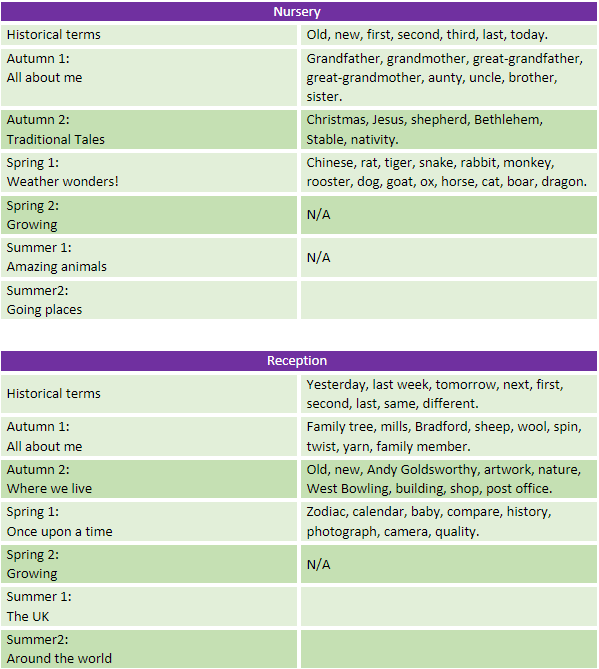
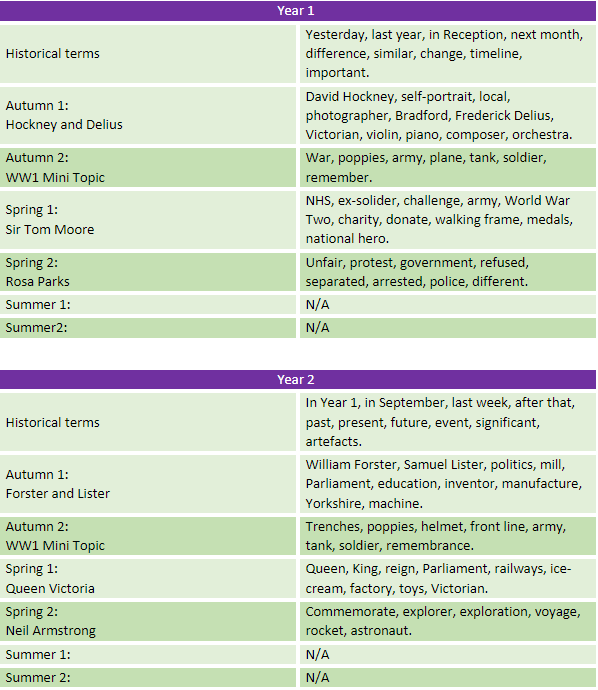
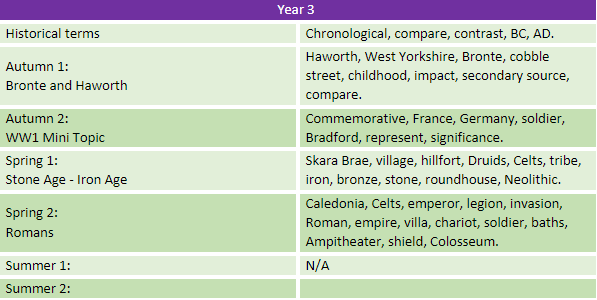
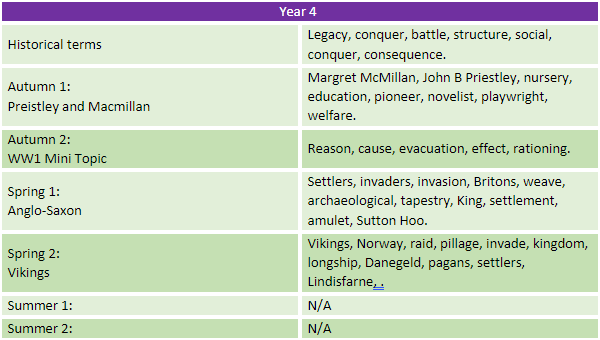
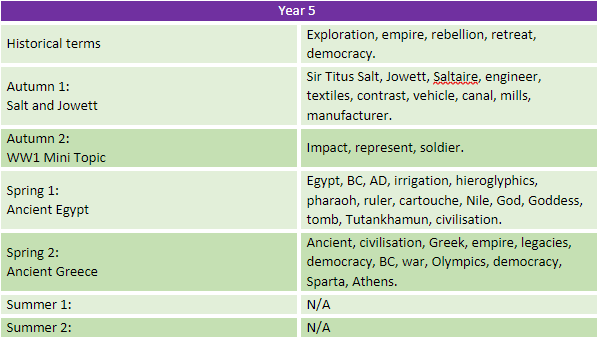
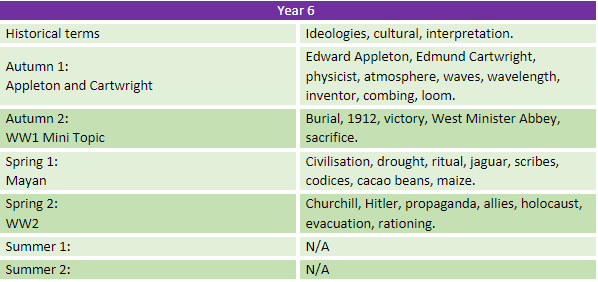
How History promotes British values
The DfE defines British values using the following:
-
Democracy - when people have equal rights and freedom to choose how they are treated.
-
Individual Liberty - when people have the freedom to choose their faith, belief, their likes, and their dislikes.
-
Rule of Law - all people are ruled by the same law to keep them safe and happy.
-
Mutual respect for and tolerance of those with different faiths and beliefs and for those without faith - a fair and permissive attitude to those whose faith and belief may differ from their own.
What this looks like in History?
-
Democracy - whilst exploring different periods in time, teachers will be aware of the difference within today’s society and raise class discussions where appropriate. This allows children to:
Compare the difference between then and now
Explore how people from the past may have felt
-
Rule of Law – once a new time period has been taught, the law of that time will be discussed as a class, and questioning from the teacher will embed the understanding of that time. This will allow children to:
Compare the law that we have in Britain
Understand any differences between the different periods in time
Question the feelings of those from the past
Half termly curriculum booklet articles
Useful websites
